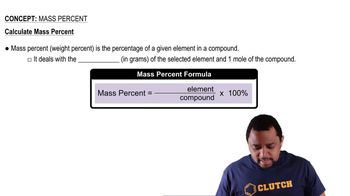Here are the essential concepts you must grasp in order to answer the question correctly.
Mass/Volume Percent (m/v)
Mass/volume percent (m/v) is a concentration expression that indicates the mass of solute in grams per 100 milliliters of solution. In this case, a 10.0% (m/v) KOH solution means there are 10 grams of KOH in every 100 mL of solution. This concept is essential for calculating how much solution can be prepared from a given mass of solute.
Recommended video:
Molarity (M)
Molarity (M) is a measure of concentration defined as the number of moles of solute per liter of solution. A 0.25 M KOH solution contains 0.25 moles of KOH in every liter of solution. Understanding molarity is crucial for converting between mass and volume when preparing solutions, as it allows for the calculation of how much solution can be made from a specific amount of solute.
Recommended video:
Stoichiometry
Stoichiometry is the branch of chemistry that deals with the quantitative relationships between reactants and products in chemical reactions. It involves using balanced chemical equations to calculate the amounts of substances consumed and produced. In this context, stoichiometry helps determine how much of each solution can be prepared based on the available mass of KOH.
Recommended video:
 Verified step by step guidance
Verified step by step guidance


